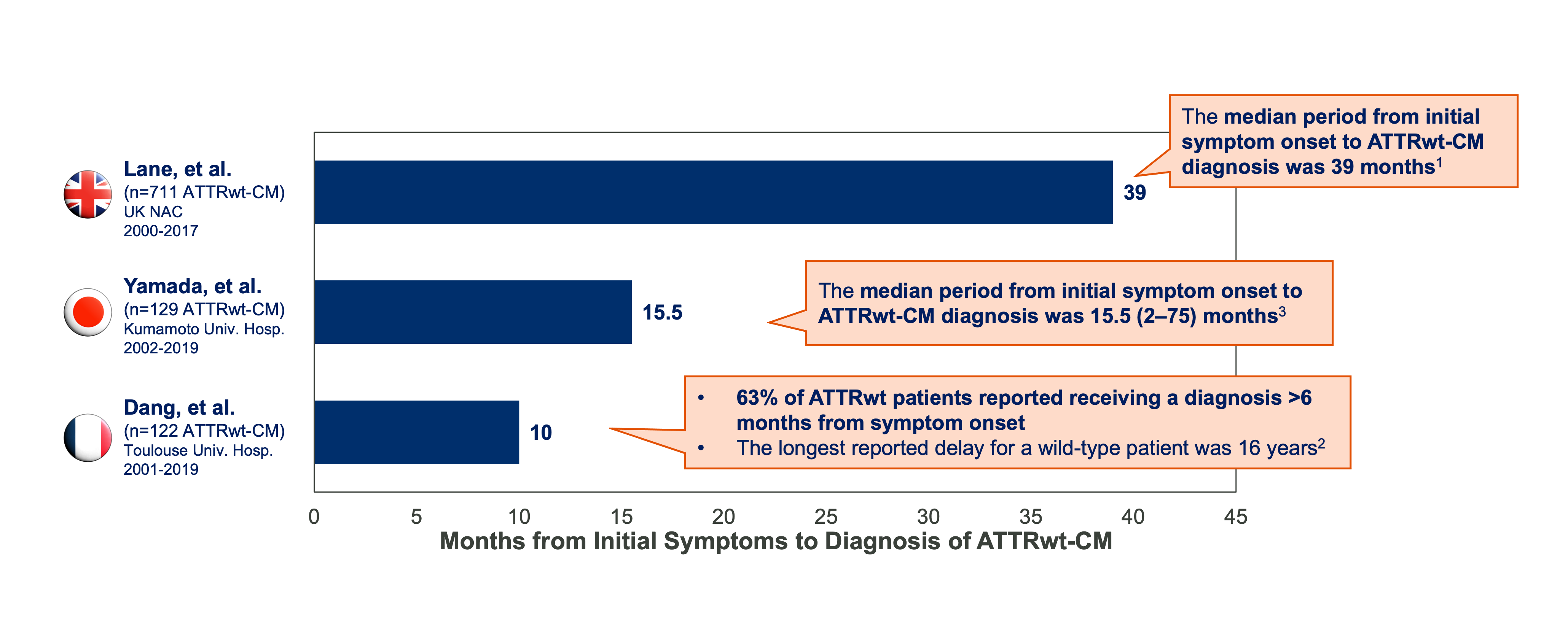they cite misdiagnosis, low awareness of CA and diagnostic algorithm / tests as top reasons for why
- Castano, et al. Cardiac Amyloidosis: Current Insights from Patients and Cardiologists Journeying Together. J. Card Fai. 2019. Vol. 25, No. 8S

Notes: * Study of 711 patients with wild-type ATTR-CM, 205 with V122I-ATTRv-CM, and 118 with non-V122I-ATTRv-CM at the UK National Amyloidosis Center between 2000 and 2017. only patients in whom there was a complete 3-year observation window across all 3 care settings prediagnosis of ATTR-CM (n=534, diagnosed April 2010 through August 2016) and a complete 3-year observation window across all 3 care settings postdiagnosis of ATTR-CM (n=364, diagnosed April 2007 through August 2013) were included in analyses of hospital service usage.1
Notes: ** Survival of patients diagnosed with ATTRwt-CM from 2012, the year that 99mTc-DPD scintigraphy was routinely introduced into the diagnostic algorithm for ATTR-CM at NAC, and after which 75% of patients were diagnosed noninvasively, was significantly better (median 60.2 months) than among patients diagnosed with ATTRwt-CM pre-2012 (median 46.3 months) when histology was usually required to establish the diagnosis (63% diagnosed via biopsy, usually endomyocardial biopsy)1
Notes: *** Consecutive patients (78.5 ± 6.4 years old at diagnosis) with ATTRwt‐CM diagnosed at Kumamoto University Hospital between December 2002 and December 2019 were retrospectively reviewed. Of 129 patients included in this study, 110 patients (85%) were male. The median period from initial symptom onset to diagnosis was 15.5 (2–75) months.3
Notes: * Study of 711 patients with wild-type ATTR-CM, 205 with V122I-ATTRv-CM, and 118 with non-V122I-ATTRv-CM at the UK National Amyloidosis Center between 2000 and 2017
Notes: ** Encouragingly, evidence suggests that survival among ATTRwt-CM patients has also improved since 2012 due to patients being diagnosed earlier in the disease course than pre-2012. Survival of patients diagnosed with ATTRwt-CM from 2012, the year that 99mTc-DPD scintigraphy was routinely introduced into the diagnostic algorithm for ATTR-CM at NAC, and after which 75% of patients were diagnosed noninvasively, was significantly better (median 60.2 months) than among patients diagnosed with ATTRwt-CM pre-2012 (median 46.3 months) when histology was usually required to establish the diagnosis (63% diagnosed via biopsy, usually endomyocardial biopsy)1
Notes: *** Using THAOS (Transthyretin Amyloidosis Outcomes Survey) data from December 2007 to January 2020, the median time from symptom onset to ATTRwt amyloidosis diagnosis did not change over the past 5 years (>60 months from 2015–2019). ATTRwt amyloidosis diagnoses increased from 2 in 2005 to >100 per year from 2016, with a more pronounced increase in the United States compared with the rest of the world. Diagnoses of ATTRwt amyloidosis by tissue biopsy increased yearly and peaked in 2014 before declining, whereas diagnoses by bone scintigraphy increased markedly since 2011.
Notes: Despite the increase in the number of patients with ATTRwt amyloidosis in THAOS, including those diagnosed in NYHA functional class I or II, and the increase in use of bone scintigraphy, there remains an unmet clinical need, with patients waiting for several years (on average) from the onset of symptoms until diagnosis. The diagnostic delay observed here may even underestimate the real-world experience of patients with ATTRwt amyloidosis. By nature of the registry, THAOS patients are in a catchment area for specialized centers with a focus and interest in this disease, whereas many patients in the real world are not and may experience greater barriers to diagnosis. Overall, the observed discrepancy between increased use of bone scintigraphy and continued prolonged time to diagnosis highlights the need for improved education on the early symptoms of ATTR amyloidosis.